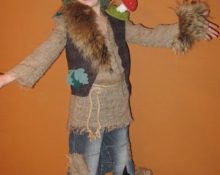Ukrainian attire is associated with wreaths, shirts, embroidery, bright ribbons and, of course, trousers. There is a deal of truth in it. The costume combines all the beauty of the Slavic soul, bright and rich colors, oriental motifs, and the elegance of Europeans.
Story
The history of traditional costume begins in ancient times, when the Slavs were not united under Kievan Rus. The country's culture is very rich, this is embodied in famous singers, actors and costumes. The design always contains bright, rich colors, this speaks of strength of spirit. All details and ornaments were created under the influence of other cultures. Costumes from different regions differ in color, embroidery and cut. This shows the distinctive features of the ethnic group.

Female – equipment, description
The basis of the costume for women and men was a shirt - embroidered shirt. The women's one differed from the men's in its length and was made from several materials. The bottom was cut from a thicker fabric. The shirt can be with or without a collar, the hem is always decorated with an ornament.The sleeves have also been beautifully embroidered and the hems can be loose or cuffed. Before the wedding, girls wore plakhas - belted long shirts with checkered embroidery. Derga was not so elegant, it was worn for work, its color was black. There are several types of headdresses for girls, these are a kibalka - a hat with a hoop on which braids are wound, a cap or bonnet - a thin cap with a cord, a wreath consisting of flowers, various colorful ribbons and scarves.

Male – equipment, description
The basis of the man's suit is an embroidered shirt. Ukrainians don’t wear a shirt for graduation; they always tuck it in. The cut is quite simple, not much different from the Russian one. The cut is in the center. Shirts on the shoulders are decorated with stripes resembling shoulder straps. The pants are harem pants that are folded inward at the top and tied with a belt at the waist. The trousers were very wide, with a frill that was sewn in the middle; the Cossacks wore such trousers.

Outerwear is varied and divided into 4 types, which differ in the cut at the back. Cloaks are a wide robe that has a hood and sleeves. Shushpan is work clothing, made from durable hard materials. Kobenyak always dressed over a fur coat, a cape that looked like a bag with a hole for the eyes. The belt was an important part of the costume; they were long and wide; the belt could be wrapped around several times. Headdresses for young men are kuchma - a hat made of ram skin, malakhai - a winter hat with earmuffs, and kabardinka - a fur hat.

Features of color and ornaments
Features include simplicity, variety of decorative elements and ornaments, bright and rich colors, slender silhouette.Simple and rather laconic elements add luxury and sophistication, Russian and Belarusian cultures are combined. Winter outfits are very practical, comfortable and beautiful. Each color is a symbol: black means the earth-nurse, red is the color of love, white symbolizes purity, blue means freedom and peace of mind, green means spring and youth, yellow very often means separation.

Natural materials are chosen as fabric, for example, linen; it is very light and comfortable. Cotton and wool are also very practical. Different regions use their own cut. Women's outfits generally always have a straight silhouette; shirts come with inserts, with a yoke, and similar to a tunic. The embroidery is very valuable as it is created by hand, mainly on the collar. In addition to the costume there are headdresses in the form of a cylinder or cone. Girls made wreaths from artificial or natural flowers as decoration.
Modern interpretation
While maintaining the main trends of folk costume, modern fashion designers offer new images that are incredibly luxurious and original. Vibrant colors and distinctive decorations effectively intertwine tradition and modern trends.




 0
0





